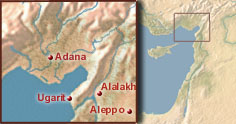home | history | nations | cities | races | people | contact
Ugarit
 Ugarit was a city on the Mediterranean coast of northern Syria. Its golden age dates from about 1450 to 1200 BCE (mid-Eighteenth to mid-Nineteenth Dynasties) and produced palaces, temples, and libraries. There was a high priests' library and other libraries on the acropolis. Family vaults under some of the stone houses show Mycenaean influence, and Mycenaean and Cypriot pottery has been found on the site.
Ugarit was a city on the Mediterranean coast of northern Syria. Its golden age dates from about 1450 to 1200 BCE (mid-Eighteenth to mid-Nineteenth Dynasties) and produced palaces, temples, and libraries. There was a high priests' library and other libraries on the acropolis. Family vaults under some of the stone houses show Mycenaean influence, and Mycenaean and Cypriot pottery has been found on the site.
Although Ugarit was influenced by Egypt, its art has a Syrian style.
Many records have been found at the temple and private libraries, some written in a unique cuneiform script. The records were written on clay tablets in four different languages (Ugaritic, Akkadian, Sumerian, or Hurrian) and seven different scripts (Egyptian and Hittite hieroglyphic, and Cypro-Minoan, Sumerian, Akkadian, Hurrian, and Ugaritic cuneiform). The Ugaritic alphabet includes 30 signs; and a shorter alphabet with 25 or as few as 22 signs seems to have been used by traders in the 13th century BCE.
The first Egyptian contact with Egypt (and the first exact dating of Ugaritic civilization) comes during the reign of the Middle Kingdom pharaoh Sesostris I, from a carnelian bead identified with him. A stela and a statuette from the Egyptian kings Sesostris II and Amenemhet III have also been found. During the 18th and 17th centuries BCE (Thirteenth Dynasty and Second Intermediate Period), Ugarit was under the control of new tribes related to the Hyksos (probably Hurrians or Mitannians) who mutiliated the Egyptian monuments.
Some texts discovered at Ugarit include the "Legend of Keret", the "Aghat Epic" (or "Legend of Danel"), the "Myth of Baal-Aliyan", and the "Death of Baal", all revealing an Old Canaanite mythology. The Ugaritic pantheon had Babylonian equivalents, and included El, Asherah of the Sea, and Baal as the main deities.